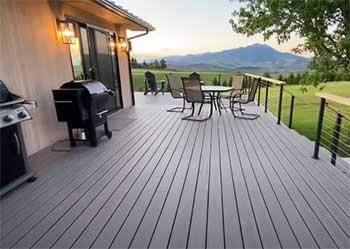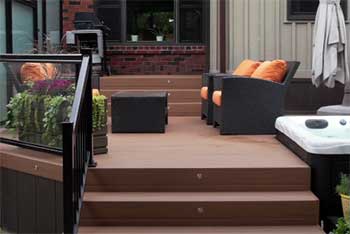Outdoor decking can completely transform your backyard or patio from drab to fab. But with so many options on the market, it can be tough to decide which materials are right for your needs and budget.
Two of the most popular decking products today are Veka and Trex. But how do you choose between them?
In this comprehensive guide, we’ll compare and contrast Veka and Trex decking to help you determine the best choice for your next deck project. We’ll look at the pros and cons of each in terms of appearance, durability, maintenance, cost, sustainability, and more.
Let’s dive in!
A Brief Comparison Table
| Feature | Veka Decking | Trex Decking |
| Material | PVC | Wood-plastic composite |
| Cost | $2 – $5 per sq. ft. installed | $7 – $15 per sq. ft. installed |
| Appearance | Traditional wood tones | Wide range of colors and wood grains |
| Durability | Impact resistant, won’t rot or warp. 50 year warranty. | Resists moisture, fading and damage. 25 year warranty. |
| Maintenance | Wash with soap and water | Wash with soap and water |
| Slip Resistance | Textured grain pattern | Select lines have textured or grooved planks |
| Sustainability | Contains some recycled PVC | Made from 95% recycled content |
| Installation | Can be installed at or below ground level | Cannot have ground contact |
Veka Decking Overview
Veka is a leading manufacturer of vinyl decking products. Their deck boards are made from rigid polyvinyl chloride (PVC) with an outer layer containing titanium dioxide pigments for UV protection and coloration.
Here are some key features and benefits of Veka decking:

- Appearance – Veka decking is designed to closely replicate the look of real wood with multi-tonal colors and wood grain patterns. Planks are available in a range of widths.
- Durability – The PVC construction is highly impact resistant and won’t rot, split, or warp like natural wood. Veka offers a 50 year structural warranty.
- Low Maintenance – Vinyl requires no staining, sealing or sanding. It resists mold, mildew and most stains. An occasional soap and water clean is all that’s needed.
- Cost – Veka is affordably priced, comparable to pressure treated lumber. Expect to pay $2-$5 per square foot installed.
- Sustainability – Veka contains a high percentage of recycled content. The PVC is recyclable at the end of its long lifespan.
- Slip Resistance – Veka decks feature a textured grain pattern for better traction underfoot when wet.
Trex Decking Overview
Trex is one of the most recognizable brands in composite decking. Their signature product combines reclaimed wood fibers and recycled plastic film to create a durable, eco-friendly alternative to solid wood decking.
Here are some of the key features and benefits of Trex decking:
- Appearance – Trex has a wide selection of natural-looking colors and convincing wood grain patterns. Planks are available in narrow and wide widths.
- Durability – The wood-plastic composite construction resists moisture, rot, cracking and insect damage. Trex provides a 25 year limited warranty.
- Low Maintenance – Requires no staining or painting. Cleans with soap and water. Resists mold and mildew.
- Cost – Trex is premium priced, starting around $7 per square foot installed. More than pressure treated wood but competitive with exotic hardwoods.
- Sustainability – Made from 95% recycled material. Trex diverts 1.5 billion pounds of waste from landfills annually.
- Slip Resistance – Trex Transcend and Select lines feature a textured grain pattern for traction. Enhance is available with a grooved surface.
- Fire Resistance – Trex meets flame spread standards for fire safety. Won’t require replacement due to fire damage.
Now that we’ve looked at their key features and benefits, let’s do a side-by-side comparison of how Veka and Trex stack up.
Key Differences Between Veka Decking And Trex
- Appearance

In terms of aesthetics, Veka and Trex are both designed to mimic real hardwoods with multi-color options and wood grain patterns.
Trex offers the most diverse selection of colors from warm medium browns to silvery gray weathered wood looks.
Veka’s color palette is focused on traditional wood tones.
Both brands are available in planks ranging from 4 inches to 6 inches wide to create a varied, natural appearance.
Trex and Veka also manufacture fascia boards and risers to provide a cohesive look.
Overall, Trex provides more options for customizing the style and appearance of your deck. But Veka still offers attractive, realistic wood looks. It will come down to personal preference.
- Durability
Veka and Trex both provide excellent durability that far exceeds traditional wood decking. Their polymer construction resists rot, cracking, splintering, and insect damage. You never have to worry about applying stain or water sealants with either brand.
Trex and Veka back their products with lengthy warranties. Trex has a 25 year residential warranty that covers staining, fading and manufacturing defects. Veka provides a 50 year structural warranty.
Both feature textured surfaces for slip resistance. Trex offers additional traction with their grooved Enhance line.
Across the board, the two brands are evenly matched when it comes to durability and low maintenance. Veka’s longer structural warranty provides an advantage.
- Cost
One of the biggest differences between Veka and Trex is cost. Veka vinyl decking is affordably priced at $2-5 per square foot installed. This is comparable to pressure treated lumber.
Trex composite decking starts around $7 per square foot installed and can go as high as $15 per square foot for top tier products. This puts Trex in line cost-wise with exotic hardwood decking.
For budget-friendly outdoor decking, Veka is clearly the more economical choice in terms of upfront cost. Trex costs significantly more but provides a higher-end look and feel.
- Sustainability
In the sustainability department, Trex has a significant advantage. Their decking contains 95% recycled content, keeping over 1.5 billion pounds of plastic and wood waste out of landfills each year.
While Veka does contain some recycled PVC, Trex uses far more reclaimed materials. Trex also uses non-toxic binding agents while Veka contains traces of vinyl chloride monomers.
Trex is the greener, more eco-friendly choice. Their reclaimed wood-plastic composite is easily one of the most sustainable decking options available today.
- Installation and Maintenance
Installing Veka and Trex decking follows similar processes. Both use hidden fasteners or screws to securely attach planks to joists while keeping the deck surface free of messy screw holes.
Maintenance requirements are also very similar. An occasional soap and water cleaning to remove dirt and debris is all that’s needed. Resealing, staining and refinishing are never required with either brand.
One difference is that Trex cannot be installed directly on concrete or in ground contact. Veka decking is specially formulated for ground level installation if desired.
Overall, Veka and Trex are on par when it comes to ease of installation and minimal maintenance needs.
Which Is Better: Veka Or Trex?
Now for the big question: which brand reigns supreme – Veka or Trex?

For budget buyers, Veka is the clear winner.
Their PVC decking provides the attractive low-maintenance qualities of Trex at a fraction of the cost.
Installation averages just $2-$5 per square foot, on par with lumber.
Trex leads the pack in aesthetics, durability, and sustainability.
Their vast color selection and wood grain options provide premium visual appeal. Trex looks and feels remarkably like real hardwood. And you can feel good about their use of recycled materials.
Here’s a quick run down of key factors that may help guide your decision:
Consider Veka decking if:
- Price is your top concern
- You prefer traditional wood tone colors
- You may install decking at ground level
- Your main goal is basic functionality
Choose Trex decking if:
- You want the highest quality composite material
- Aesthetics are very important – tons of color/style options
- Eco-friendliness matters to you
- You want added traction and durability
- Your deck is a home feature and splurge item
While Veka vinyl and Trex composite each have advantages in certain areas, both are excellent choices that will suit the needs of many homeowners. Keep your project goals, budget, and lifestyle in mind as you decide whether Veka or Trex is right for your outdoor oasis.
Frequently Asked Questions (FAQ)
Still trying to choose between Veka and Trex? Here are answers to some commonly asked questions about each brand.
Yes, Veka is an excellent mid-priced PVC decking brand. Their products feature realistic wood grain patterns, fade and stain resistance, a long warranty, and durable construction. Veka offers the look of wood without the maintenance. It’s great for cost-conscious consumers.
While Trex is a premium brand, a few competitors also offer exceptional composite and PVC decking. TimberTech Azek and Fiberon are two quality alternatives. That said, Trex remains an industry leader known for technological innovation.
On average, expect to pay $2 – $5 per square foot for Veka decking installation. This MVP vinyl product line is affordably priced, comparable to pressure treated lumber.
Veka PVC decking costs 50-75% less than Trex while providing similar performance and low-maintenance qualities. It’s an excellent budget option that still looks great. Capped wood-plastic composites can also cost less than Trex.
Final Thoughts
When it comes to choosing exterior decking materials, Veka and Trex both make fantastic options. Veka PVC provides an affordable wood-look alternative requiring minimal upkeep. For those seeking premium performance and aesthetics, Trex composite is the leading choice but comes at a higher price.
Carefully assess your project budget, design goals, color preferences, and sustainability aims. This will help point you towards Veka or Trex as the ideal solution for upgrading your outdoor living area.
Whichever you choose, you can enjoy years of lasting durability and beauty with your new dream deck.
